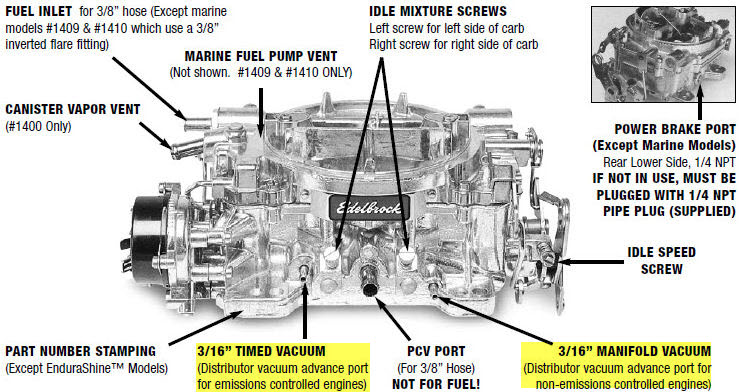
 |
|
|
#26 |
|
Registered User
Join Date: Feb 2008
Location: Surprise, Ariz.
Posts: 186
|
Re: timing degrees
Rich the left side of carburetor PASSENGER SIDE LOOKING FROM FRONT OF THE ENGINE. The vacuum advance is hooked to the PASSENGER side port. I am going to leave vacuum attached and drive it as Wade suggested. AS of now the brakes have to be bled before i can drive. will get back to you. frankyjoe
|
|
|

|
|
|
#27 |
|
Registered User
Join Date: Apr 2014
Location: Bloomington Indiana
Posts: 1,041
|
Re: timing degrees
Well, like I said, that's not the left side. Everything should be referenced from looking forward.
So it is on the wrong port. It should be on the drivers side port, and the passenger side port plugged off. See Edelbrock diagram from their instructions. 
__________________
Rich Weyand 1978 K10 RCSB DD. |
|
|

|
|
|
#28 |
|
Registered User
Join Date: Feb 2008
Location: Surprise, Ariz.
Posts: 186
|
Re: timing degrees
rich, i noticed in the pic the power brake port on the back of carb. I have my hose from the power brake unit to the Edlebrock manifold. Should i plug the manifold and attach hose to the power brake port. i'll change the vacuum setup and get back to you. The carb in the pic is exactly like mine. Thanks so much. you are awesome. frankyjoe
|
|
|

|
|
|
#29 |
|
Registered User
Join Date: Apr 2014
Location: Bloomington Indiana
Posts: 1,041
|
Re: timing degrees
That power brake port is there on the back because some manifolds don't have it. It makes no difference which you are connected to, because they are both the same vacuum source, manifold vacuum.
There is a difference between the two ports on the front of the carb, though. From 1939 through the end of 1967, GM cars always ran the vacuum advance off of manifold vacuum (drivers side port). Beginning in 1968, GM cars ran off of ported vacuum (passenger side port) to accommodate pollution controls. GM trucks moved to ported vacuum over time as pollution controls were applied to trucks. Without an AIR pump on your engine, you should use the drivers side port. Glad I can help is all. I would never have gotten my truck to where it is without the help of other people, both on the forums and elsewhere, and I get a kick out of helping others get to the same place. I think if you move to manifold vacuum, and get the right vacuum canister on that distributor, a lot of your troubles will clear up.
__________________
Rich Weyand 1978 K10 RCSB DD. |
|
|

|
|
|
#30 |
|
Registered User
Join Date: Feb 2008
Location: Surprise, Ariz.
Posts: 186
|
Re: timing degrees
rich, its been a while but the engine doesn't pop. Had a tune-up at a local garage while i was in CA. runs great. Did not change the vacuum advance or move vacuum hose. new plugs and re-timed to 12 tdc. at the moment i am breaking the engine slowly, have all new parts internally. How many miles does it take to break in? i remember i used to take from 0 to 50 back-off for the first 50 miles. thanks for all the help you guys are great. frankyjoe 73

|
|
|

|
|
|
#31 |
|
Registered User
Join Date: Apr 2014
Location: Bloomington Indiana
Posts: 1,041
|
Re: timing degrees
Moving the vacuum hose will make a big difference.
GM says: The engine should be driven at varying loads and conditions for the first 30 miles or one hour without wide open throttle (WOT) or sustained high RPM accelerations. Change the oil and filter. Replace with 10w30 motor oil (non synthetic) and a PF454 or PF1218 AC Delco oil filter. Inspect the oil and the oil filter for any foreign particles to ensure that the engine is functioning properly. Drive the next 500 miles under normal conditions or 12 to 15 engine hours. Do not run the engine at its maximum rated engine speed. Also, do not expose the engine to extended periods of high load. Change the oil and filter. Again, inspect the oil and oil filter for any foreign particles to ensure that the engine is functioning properly. Do not use synthetic oil for break-in. It would be suitable to use synthetic motor oil after the second recommended oil change and mileage accumulation. In colder regions, a lower viscosity oil may be required for better flow characteristics.
__________________
Rich Weyand 1978 K10 RCSB DD. |
|
|

|
|
|
#32 |
|
Registered User
Join Date: Aug 2010
Location: east tx
Posts: 128
|
Re: timing degrees
It might make sense to get it ready to run before tackling tuning. Eliminating vacuum advance was a 1960s drag racing thing to do. It made sense when gas was incredibly cheap and full of lead, vehicles were raced at wide open throttle and had huge lumpy cams that killed vacuum anyway, and the overriding sentiment was "When in doubt, run it rich, and you won't burn your valves" Some things are not better today, but in my opinion, how the average hot rodder deals with air fuel ratio and ignition timing is exponentially more sophisticated than it was then. If that tech told you to eliminate vacuum advance on a street vehicle, I think he may be thinking of his truck, which is probably tuned to run on whatever moonshine he doesn't manage to gulp down immediately before his shift as a phone jockey.
There is a big difference in oil filter quality between different manufacturers, I have noticed. It is sometimes good to break one open and see what is inside, in order to have good engine protection.
__________________
jjmorrse 86 C30 crewcab big dooley. 454- 400 Last edited by jjmorrse; 02-02-2016 at 11:26 AM. |
|
|

|
|
|
#33 |
|
Registered User
Join Date: Apr 2014
Location: Bloomington Indiana
Posts: 1,041
|
Re: timing degrees
Racers today still don't use vacuum advance. It's just another thing to break.
__________________
Rich Weyand 1978 K10 RCSB DD. |
|
|

|
|
|
#34 |
|
Registered User
Join Date: Aug 2010
Location: east tx
Posts: 128
|
Re: timing degrees
Right, thanks. There is a little thing called circle track I wasn't event thinking about. I was thinking of the tendency of hot rodders to put on racing parts when their vehicle was going to be used on the street most of the time, except for the occasional streetlight dragstrip.
__________________
jjmorrse 86 C30 crewcab big dooley. 454- 400 |
|
|

|
|
|
#35 |
|
Registered User
Join Date: Jun 2014
Location: CO
Posts: 739
|
Re: timing degrees
I assume since it is a 73 truck that it had a points distributor right? Did you make sure to run a constant 12v to HEI and not use the resistor wire that ran to original coil?
__________________
79 Chevy 2wd BIG10 350 TH400 |
|
|

|
|
|
#36 | |
|
Registered User
Join Date: Apr 2014
Location: Bloomington Indiana
Posts: 1,041
|
Re: timing degrees
Quote:
__________________
Rich Weyand 1978 K10 RCSB DD. |
|
|
|

|
|
|
#37 | |
|
Registered User
Join Date: Apr 2014
Location: Bloomington Indiana
Posts: 1,041
|
Re: timing degrees
Quote:
Just a little explanation. Points ignition systems suffered a weak spark on starting, when battery voltage is depressed by providing starter current. The solution was to use a 6-volt coil with a series resistor. When the engine was started, and battery voltage was low, the coil current was also low due to the long gaps between firing at the low rpm of the starter. So the 7 to 8 volts of the battery provided plenty of spark through the 6-volt coil. When the engine started, and coil current went up, the resistor in series with the coil held the applied voltage to the coil down to 6 or 7 volts so the coil didn't burn up. Modern HEI systems don't have the same issues with generating a hot enough spark at the reduced battery voltage during starting, so HEI distributors use 12-volt coils and connect directly to the ignition wire without a resistor wire in series.
__________________
Rich Weyand 1978 K10 RCSB DD. Last edited by rich weyand; 02-02-2016 at 12:37 PM. |
|
|
|

|
|
|
#38 | |
|
Registered User
Join Date: Feb 2008
Location: Surprise, Ariz.
Posts: 186
|
Quote:

|
|
|
|

|
|
|
#39 |
|
Registered User
Join Date: Jun 2014
Location: CO
Posts: 739
|
Re: timing degrees
Hey fankyjoet you have to test the wire that plugs into the HEI cap. The wire that is running from the factory harness. A good way to tell if it is a resistor wire from GM is if it has a cloth covering the wire running to HEI. Also you can just test wire with a volt meter and turn key to on position and check voltage. So you need to check the wire leading to HEI, if you are not getting 12v to HEI you will have very weak voltage at spark plugs
__________________
79 Chevy 2wd BIG10 350 TH400 |
|
|

|
 |
| Bookmarks |
|
|